Blean, Kent
Up to 1834
Following Knatchbull's Act of 1723, a house in the Borough of Hampton (now the centre of Herne Bay) was occupied as a workhouse.
A parliamentary report of 1777 recorded parish workhouses in operation at Chislett (for up to 33 inmates), Hearne (30), St Dunstan (26), Sea Salter (16), Steeplegate (6), Sturry (50), and Whitstable (42).
In 1791, the Vicar of Herne and certain parishioners paid £20 for a small piece of land on the Canterbury Road leading out of Herne. A workhouse was built at a cost of £772.1s.7½d and although no formal union was in operation, places in the workhouse were made available (at a cost) to other neighbouring parishes.
A Gilbert Unionwas formed in 1807 with its workhouse located in the precincts of the Archbishop's Palace, Canterbury. Its members eventually included: the Precinct of Archbishop's Palace, Beakesbourne, Bridge, Canterbury Christchurch, Canterbury St Cosmus and St Damian in the Blean, Canterbury Saint Gregory, Hackington (or St Stephen), Hoath, Lower Hardres, Nackington, Patrixbourne, Staplegate, Stodmarsh, Stourmouth, Swalecliffe, Thannington and Westbere. In 1833, it was reported that the combined ages of twenty of the inmates was 1,460, an average of 73 years.
A Gilbert Union based at Whitstable was formed in 1821, its other members being Chislett and Sturry.
After 1834
Blean Poor Law Union was formed on 20th April 1835. Its operation was overseen by an elected Board of Guardians, 19 in number, representing its 16 constituent parishes as listed below (figures in brackets indicate numbers of Guardians if more than one):
Kent:
Canterbury — St Gregory, Canterbury — Christchurch, Chislett (2), Hackington (alias St Stephens), Herne (otherwise Hearne) (2), Hoath, Precinct of Archbishop's Palace, Reculver, St Cosmus and St Damion in the Blean, St Dunstan, Seasalter, Sturry (otherwise Sturrey), Staplegate, Swalecliffe, West-beer (otherwise Westbere), Whitstable (2).
Later Addition: Herne Bay (from 1894)
The population falling within the union at the 1831 census had been 10,639 with parishes ranging in size from Swalecliffe (population 133) to Herne (1,876) and Whitstable (1,926). The average annual poor-rate expenditure for the period 1831-34 had been £12,224 or £1.3s.0d. per head.
Built in 1835 on a four-acre site to the south of Herne Common, the Blean Union Workhouse was designed by William Edmunds and based on Sir Francis Head's Plan of a Rural Workhouse for 500 Persons published by the Poor Law Commissioners in that year. The design was of yellow stock brick construction and comprised a large quadrangle enclosed by two-storey buildings, a plan used in other Kent Unions such as Maidstone. The courtyard plan workhouse was envisaged as a long row of pauper cottages wrapped around to form a square. The workhouse location and layout are shown on the 1906 map below:
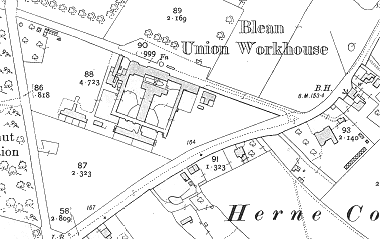
Blean workhouse site, 1906.
The entrance block lay at the north of the site.
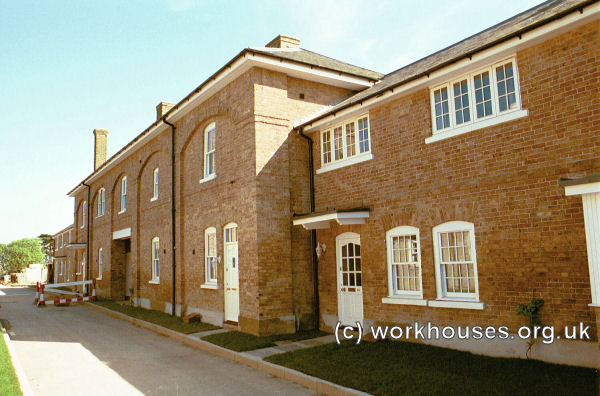
Blean entrance block from the north-west, 2001.
© Peter Higginbotham.
An impressive water tower stood opposite the entrance.
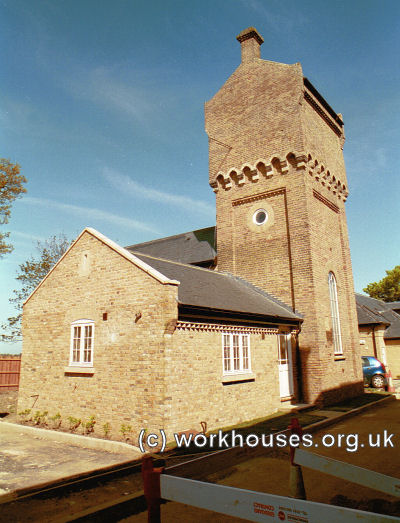
Blean water tower from the west, 2001.
© Peter Higginbotham.
In order to keep the building costs below a ceiling of £5,000 several cost-cutting measures were adopted. These included the omission of any outside drains (something that would later cause problems when water attacked the building's foundations) and an absence of any outside windows. In 1841, a visitor from the continent described the building as a "windowless Herne Bastille... a receptacle for the outworn poor" (Lansberry, 1984).
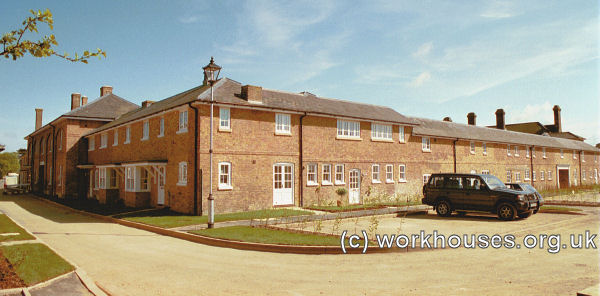
Blean entrance block and west wing from the north-west, 2001.
© Peter Higginbotham.
A visitor to the workhouse in 1838 recorded that:
You can read the full account of the visit here.
Discipline in the workhouse was severe. After committing a minor offence, a nine-year old girl was shut up for the night with a corpse in the mortuary, although a subsequent enquiry led to the Master and Matron being dismissed.
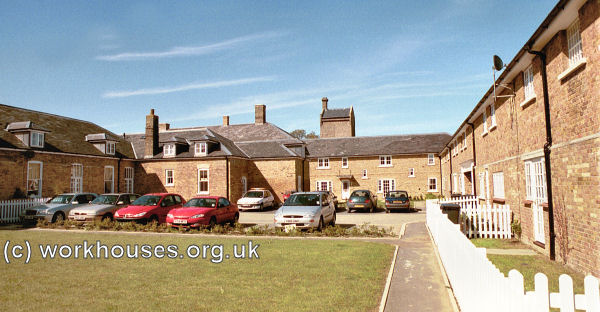
Blean courtyard interior from the south, 2001.
© Peter Higginbotham.
A new 60-bed two-storey hospital block was added at the south in 1874-5, together with a single storey isolation block to the west.
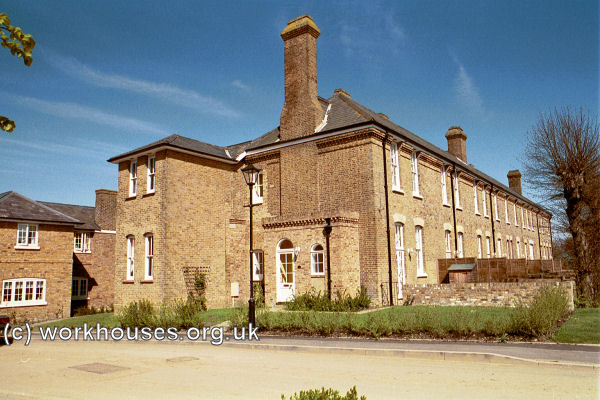
Blean hospital block the west, 2001.
© Peter Higginbotham.
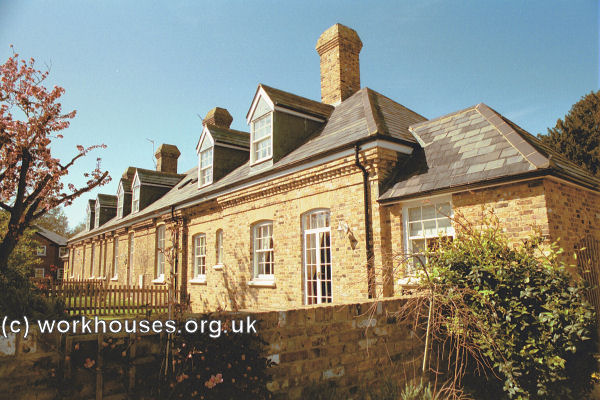
Blean isolation block from the east, 2001.
© Peter Higginbotham.
In 1918, the military occupied part of the workhouse for the treatment of convalescent servicemen.
The site was taken over by Kent County Council in 1930 as a home for women with epilepsy or severe learning difficulties. By 1939, it was almost self-supporting in vegetables and fruit, and pigs and rabbits were kept, the rabbit skins being sold for glove-making. After 1948, the establishment joined the NHS as Herne Hospital, providing care for the chronic sick. After its closure in around 1986, the buildings were redeveloped for residential use.
Scattered Homes
By 1913, the Blean Union was operating two children's scattered homes. One, for girls, was known as 'Glenholm' and located on Mill Lane, Herne; the other, for boys, was called 'Lyndhurst', and situated just off Mill Lane, on Kingsfield Road. The homes had a combined capacity of thirty places.
Staff
Inmates
Records
Note: many repositories impose a closure period of up to 100 years for records identifying individuals. Before travelling a long distance, always check that the records you want to consult will be available.
- Kent History and Library Centre, James Whatman Way, Maidstone, Kent ME14 1LQ Holdings include: Guardians' minutes (1835-1930); Births (1836-1866); Deaths (1848-1914); Creed registers (1880-1914); Register of lunatics (1859-1923); Punishments book (1862-1922); Emigration papers (1843-1911); Bastardy orders (1844-96); etc.
Bibliography
- Higginbotham, Peter Workhouses of London and the South East (2019)
- The Blean Bastille: Blean Poor Law Union 1835-46 by HCF Lansberry (in Hoath and Herne — the Last of the Forest ed. by KH McKintosh & HE Gough, 1984)
Links
- None.
Unless otherwise indicated, this page () is copyright Peter Higginbotham. Contents may not be reproduced without permission.


